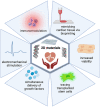2D Materials for Cardiac Tissue Repair and Regeneration
- PMID: 35224044
- PMCID: PMC8873146
- DOI: 10.3389/fcvm.2022.802551
2D Materials for Cardiac Tissue Repair and Regeneration
Abstract
Cardiovascular diseases (CVDs) have a massive impact on human health. Due to the limited regeneration capacity of adult heart tissue, CVDs are the leading cause of death and disability worldwide. Even though there are surgical and pharmacological treatments for CVDs, regenerative strategies are the most promising approaches and have the potential to benefit millions of people. As in any other tissue engineering approach, the repair and regeneration of damaged cardiac tissues generally involve scaffolds made up of biodegradable and biocompatible materials, cellular components such as stem cells, and growth factors. This review provides an overview of biomaterial-based tissue engineering approaches for CVDs with a specific focus on the potential of 2D materials. It is essential to consider both physicochemical and immunomodulatory properties for evaluating the applicability of 2D materials in cardiac tissue repair and regeneration. As new members of the 2D materials will be explored, they will quickly become part of cardiac tissue engineering technologies.
Keywords: cardiovascular disease; cardiovascular regeneration; conductive biomaterials; stem cell therapy; two-dimensional nanomaterials.
Copyright © 2022 Gokce, Gurcan, Delogu and Yilmazer.
Conflict of interest statement
The authors declare that the research was conducted in the absence of any commercial or financial relationships that could be construed as a potential conflict of interest.
Figures


Similar articles
-
Conductive polymers for cardiac tissue engineering and regeneration.J Biomed Mater Res B Appl Biomater. 2023 Nov;111(11):1979-1995. doi: 10.1002/jbm.b.35293. Epub 2023 Jun 12. J Biomed Mater Res B Appl Biomater. 2023. PMID: 37306139 Review.
-
Artificial Scaffolds in Cardiac Tissue Engineering.Life (Basel). 2022 Jul 25;12(8):1117. doi: 10.3390/life12081117. Life (Basel). 2022. PMID: 35892919 Free PMC article. Review.
-
Recent Advances in the Application of Two-Dimensional Nanomaterials for Neural Tissue Engineering and Regeneration.ACS Biomater Sci Eng. 2021 Aug 9;7(8):3503-3529. doi: 10.1021/acsbiomaterials.1c00490. Epub 2021 Jul 22. ACS Biomater Sci Eng. 2021. PMID: 34291638 Review.
-
Application of Nanomaterials in Stem Cell-Based Therapeutics for Cardiac Repair and Regeneration.Small. 2023 Mar;19(11):e2206487. doi: 10.1002/smll.202206487. Epub 2023 Jan 15. Small. 2023. PMID: 36642861 Review.
-
Biomaterials strategies to balance inflammation and tenogenesis for tendon repair.Acta Biomater. 2021 Aug;130:1-16. doi: 10.1016/j.actbio.2021.05.043. Epub 2021 May 31. Acta Biomater. 2021. PMID: 34082095 Review.
Cited by
-
Progress in Biomaterials for Cardiac Tissue Engineering and Regeneration.Polymers (Basel). 2023 Feb 26;15(5):1177. doi: 10.3390/polym15051177. Polymers (Basel). 2023. PMID: 36904419 Free PMC article. Review.
-
Supramolecular Hydrogels from a Tripeptide and Carbon Nano-Onions for Biological Applications.Nanomaterials (Basel). 2022 Dec 30;13(1):172. doi: 10.3390/nano13010172. Nanomaterials (Basel). 2022. PMID: 36616081 Free PMC article.
-
Contemporary Challenges of Regenerative Therapy in Patients with Ischemic and Non-Ischemic Heart Failure.J Cardiovasc Dev Dis. 2022 Dec 1;9(12):429. doi: 10.3390/jcdd9120429. J Cardiovasc Dev Dis. 2022. PMID: 36547426 Free PMC article. Review.
-
Three-Dimensionally Printed Hydrogel Cardiac Patch for Infarct Regeneration Based on Natural Polysaccharides.Polymers (Basel). 2023 Jun 26;15(13):2824. doi: 10.3390/polym15132824. Polymers (Basel). 2023. PMID: 37447470 Free PMC article.
-
Elucidation of Potential Genotoxicity of MXenes Using a DNA Comet Assay.ACS Appl Bio Mater. 2024 Dec 16;7(12):8351-8366. doi: 10.1021/acsabm.4c01142. Epub 2024 Dec 3. ACS Appl Bio Mater. 2024. PMID: 39625730 Free PMC article.
References
-
- Rezaie HR, Bakhtiari L, Öchsner A. Biomaterials and Their Applications. Cham: Springer; (2015). 10.1007/978-3-319-17846-2 - DOI
-
- Kiran ASK, Ramakrishna S. An Introduction to Biomaterials Science and Engineering. Singapore: World Scientific; (2021). 10.1142/12038 - DOI
-
- Bose S, Bandyopadhyay A. Introduction to biomaterials. In: Bandyopadhyay A, Bose S, editors. Characterization of Biomaterials. Elsevier: (2013). p. 1–9. 10.1016/B978-0-12-415800-9.00001-2 - DOI
Publication types
LinkOut - more resources
Full Text Sources
Research Materials

